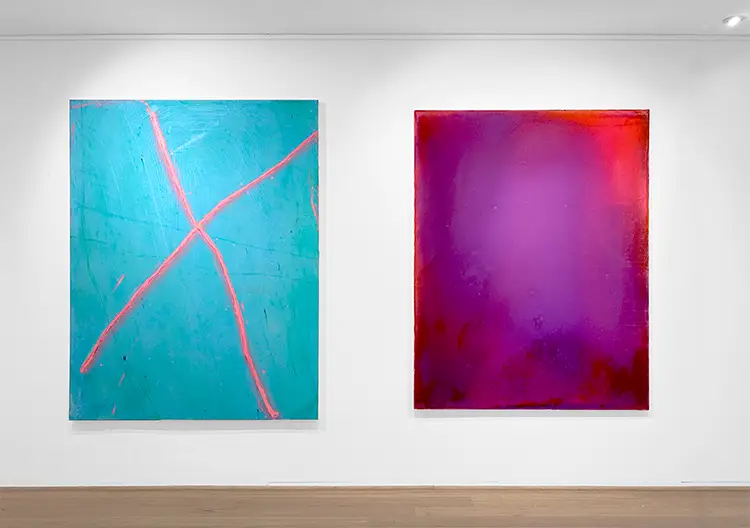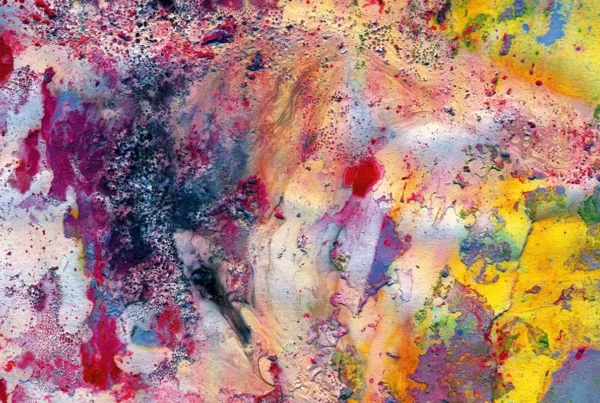Unsettled Surfaces: Painting as a Living Dialogue
In a landscape of contemporary abstraction, Taylor O. Thomas has carved a distinct place for herself by treating painting as an experiential and expressive practice—one that captures both visceral emotion and intellectual inquiry. Her gestural works are neither static statements nor decorative forms; instead, they operate as open-ended investigations into the links between human perception, bodily instinct, and inner cognition. Working across abstract painting, drawing, and installation, she constructs images that often feel improvised yet are underpinned by a rigorous attentiveness to color, mark, and surface. Based in Tampa, Florida, and originally from Birmingham, Alabama, Thomas continues to push the expressive potential of her materials, using them not merely as tools but as collaborators in a process of making meaning.
Her works have garnered international attention, appearing in collections and exhibitions in the United States, China, Italy, Singapore, Australia, and Spain. Behind this widespread recognition is a practice deeply grounded in discipline and intuition. Thomas earned her BA in Studio Art from Davidson College in 2012, graduating magna cum laude. She later pursued an MFA at the University of South Florida, where she received a University Graduate Fellowship, reflecting both her academic rigor and studio commitment. Alongside her formal education, she has attended numerous prestigious residencies, including Vermont Studio Center and Benaco Arte in Italy, each experience enriching her exploration of material, form, and spatial context.
Beyond her canvases, Thomas’s voice and vision have resonated in roles such as Publication Juror for Friend of the Artist and as a recipient of accolades including the Innovate Artist Grant and a Peripheral Vision Publication Fellowship. But what defines her most is not the list of honors—it’s her persistent inquiry into how painting can operate as a kind of physical thinking. Her mark-making is not performative for the sake of drama; rather, it is a mode of discovery, an articulation of questions that resist easy answers. She refers to her work as an “evolving story” and sees each layer not as a conclusion but a continuation, a principle that guides every surface she touches.

Taylor O. Thomas: Reframing Recovery Through the Hand
The Period Comma Sunset series stands as a pivotal point in Thomas’s practice, not only for its conceptual and emotional richness but for its timing. The first piece in the series, “Screened,” emerged in 2019 during her recovery from wrist surgery on her dominant hand. Limited physically but driven by the need to create, Thomas turned to smaller works on paper—a shift that would ultimately inform the entire series. The immediacy of the medium offered her a way to bypass the formal burdens of large-scale canvas work and enter a space where gesture could flow freely. That physical limitation became a creative aperture, setting the tone for what would soon be an expansive body of work influenced by the collective trauma of the COVID-19 pandemic.
When the world shut down in 2020, Thomas, like many artists, found herself navigating an altered emotional and social terrain. The structure of Period Comma Sunset—works on 30×22 inch paper, all in vertical orientation—reflected a desire for both constraint and freedom. While the dimensions and surfaces were uniform, the visual content within each piece varied dramatically. By unifying the format, she allowed for a diversity of expression that mirrored the fluctuating mental states and environmental uncertainties of that time. Her decision to work exclusively on paper wasn’t merely practical; it was an extension of her need for vulnerability, intimacy, and rawness in the face of global instability.
What makes the series even more significant is its ability to speak collectively and individually. Influenced by installation art and the work of painters such as Charline von Heyl, Laura Owens, and Amy Sillman, Thomas envisioned each painting not as a solitary object but as a contributor to a greater dialogue. This curatorial mindset elevated the series beyond a group of pandemic-inspired works—it became a meditation on relationality itself. The paintings interact, contradict, complement, and sometimes challenge one another, much like the artist’s own emotional responses during the pandemic. It’s an approach that echoes Thomas’s deeper ambition: to use painting not just as a reflection of the self but as a mirror held up to the collective complexities of our time.

Material Tension and the Space Between
Central to Thomas’s practice is an unshakable devotion to process. She doesn’t approach the studio with rigid expectations; instead, she allows herself to be guided by the evolving conversation between material and gesture. Often, her work begins with emotional impetus, but it rarely stays within those bounds. Unexpected marks, the collision of incompatible colors, or the erratic behavior of media on surface frequently redirect the course of a painting. This openness creates a tension that is both visual and conceptual, where form serves as both record and improvisation. She embraces this uncertainty, often discovering her most resonant images only through letting go of control.
Her engagement with lyricism—while present—is never overt. While her paintings often carry a poetic energy, Thomas doesn’t rely on traditional narratives or metaphoric devices to evoke emotion. Instead, any lyrical quality emerges from her willingness to explore dissonance and harmony within the act of making. The resulting works pulse with energy, at times unruly but always grounded in a thoughtful relationship with their own making. This balance between expressiveness and restraint enables her paintings to exist in that rare space where the intuitive meets the analytical. Each image feels alive, not only because of its visible gestures but because it seems to hold a memory of the artist’s hand, thought, and body in motion.
This insistence on process also influences how Thomas arranges her studio environment. Rather than isolating works or progressing linearly through a single painting, she surrounds herself with multiple pieces, allowing them to speak to and affect each other. A decision made on one canvas might directly inform the next, reinforcing the idea that none of her paintings exist in a vacuum. They are part of a larger conversation, one that includes past works, future ideas, and the immediate present of her studio surroundings. This network of interrelations gives her practice a distinct rhythm, one that respects the individual moment of creation while acknowledging its place within a broader, living archive.

Taylor O. Thomas: A Daily Practice of Immersion and Intuition
Thomas’s studio routine reflects the same interplay of discipline and fluidity that defines her painting. Rather than prescribing a rigid schedule, she approaches each day with openness, guided by ritual and sensory cues. After grounding herself through journaling or simple tasks, she transitions into the studio—a space where the very act of removing her shoes and donning her paint-covered gear signals a psychological shift. Painting for Thomas isn’t just about aesthetic outcomes; it’s a full-bodied engagement with space, material, and energy. Her method of “cleaning” often becomes the first brushstroke, a spontaneous entry into a rhythm that she doesn’t so much control as respond to.
Instead of working sequentially, Thomas allows multiple works to emerge simultaneously. Canvases line her walls and floors, each influencing the other like voices in a chorus. One piece might be on the verge of completion while another remains raw and unresolved for months. She moves between them in a constant state of evaluation, never entirely sure which will speak to her next. What might seem chaotic is in fact a deeply intuitive process, rooted in a sensitivity to visual balance, spatial resonance, and emotional presence. This practice enables her to remain in dialogue with her work across time, returning to images with fresh perspectives and allowing them to evolve organically.
She admits that her practice often runs counter to her personality outside the studio. While she is a planner in most areas of life, painting requires her to abandon expectation and embrace uncertainty. If she tries to impose too much structure or forethought, the work falters. That paradox—of a thoughtful artist who thrives in the unpredictable—lies at the heart of her most powerful paintings. Whether she’s confronting personal questions or responding to wider social experiences, Thomas allows each gesture to emerge from a place of authenticity. Her paintings are not the result of control but of attentiveness, not blueprints but byproducts of presence. This ethic not only animates her individual works but continues to define the trajectory of her evolving body of art.








